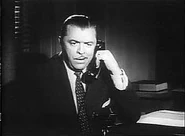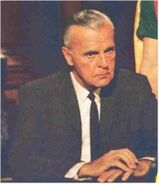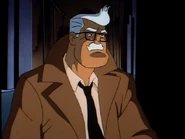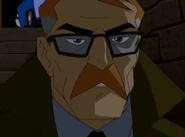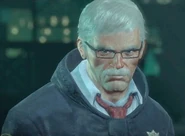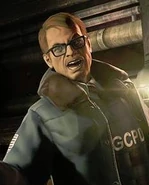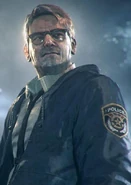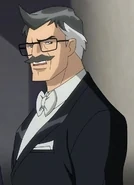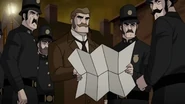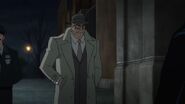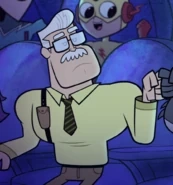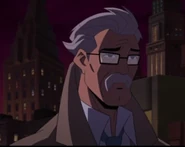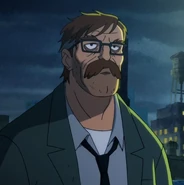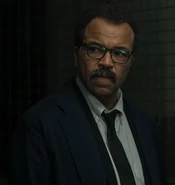James "Jim" Gordon is the Police Commissioner of Gotham City. He shares the Batman’s deep commitment to ridding the dark and corrupt city of crime.
Although he is somewhat skeptical of Batman's vigilante method, he ultimately recognizes the necessity of Batman and the two have a mutual respect and tacit friendship. Gordon is also the father of Barbara Gordon, who fights crime alongside Batman as Nightwing, keeping the secret even from him.
Physical Appearance[]
James Gordon is a slim adult male with short reddish-brown hair and a thick mustache. He also generally wears a brown trench coat and thick, horn-rimmed glasses.
Personality[]
Gordon is fully devoted to cleaning up the corruption in the political offices and in GCPD, a goal he has come along way to accomplishing as police commissioner. He was usually a mild-mannered man, which lead some unobservant people to believe he is easily intimidated—to their regret. Although he doesn't approve of Batman's methods, his wiliness to go outside of the law and the mysterious vigilante's interference in police business, he ultimately recognizes the necessity of Batman and lets him handles the problem when needed.
Powers and Abilities[]
- Criminology: James Gordon received an honorary doctorate in the field of criminology from Gotham State University.
- Hand-to-Hand Combat: Gordon served in the United States military and was trained in hand-to-hand combat. By his own account, his martial prowess was honed to the point that he could defeat a Green Beret in physical combat.Jim Gordon possesses the strength level of a man his age, size and weight who engages in moderate regular exercise. Jim Gordon Is very athletic with above average strength.
- Law: James Gordon is proficient in all aspects of criminal detective work and police procedural matters. He also has a keen instinct in regards to the political aspects of managing the Gotham City Police Department.
- Detective Skills: Gordon has extreamly advanced investigations skills, which makes him one of the finest detective in Gotham City Police Departement.
- Indomitable Will: He has also shown remarkable strength of will and an ability to maintain his mental fortitude and sanity.
- Leadership: He is also an expert leader, having spent decades as the leader of the world's most corrupt police force in the most dangerous city. That he has managed to not only survive, but to make Gotham PD stronger is a testament to his abilities.
- Marksmanship: As a militar and a policeman, Gordon is trained whit many kind of firearms.
- Military Protocol: In his youth, Gordon served in the United States military.
Early History[]
Not much is known about Jim Gordon's past except that he is not a Gotham City native and that served in the United States military before to becoming a police officer and fight against the Police Departement's corruptions.
Becoming progressively the hero of the city because of his honesty, he was quickly promoted to commissioner.
Season Eleven[]
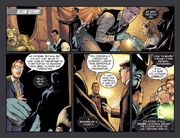
Gordon confronting Batman on the attack in the sewers.
In the sewer tunnel where Batman and Nightwing encountered the White Martian, the place is crawling with Gotham City police detectives, commanded by police commissioner James Gordon. Stepping from the shadows, Batman tells Gordon he needs the cops out for the time being. Gordon is initially reluctant and Detective John Jones tells him this is a bigger problem than what's occurring in the city. Using a portable projector, Batman explains how he ran the Martian glyph through federal databases and revealed multiple locations where it has appeared over the past eighteen months. They identify it as a message and John tells them that the Martian got his attention with it: the symbol for his Martian name. Gordon clears the room of the detectives.
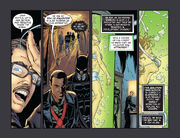
Jim leaving the crime scene for Batman and John Jones to handle.
John confronts Batman about Gordon being unaware that his daughter is serving as the Dark Knight's apprentice and says that as a father he has a right to know that she was attacked. Batman explains that the solution she is suspended in at the cave will heal her wounds within hours. Other than some anxiety when she first emerges from the tank, Barbara will be fine, Batman assures John.

Gordon and Batman investigate the murder of a young man in Superman suit.
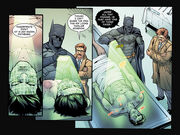
Gordon and Batman examine the body of the victim.
Months later, Gordon lights a cigarette while waiting for the arrival of the dynamic duo and starts to countdown. On their arrival, he questions the whereabouts of Bane and Batman tells him that he can be found in a warehouse, depowered. Gordon then shows to him a corpse of a young man in a Superman T-shirt and he tells Batman that this sort of hate crime is right up his alley.
In the morgue, Batman and Commissioner Gordon examine the body of the deceased "Clark". Batman scans the body with a device, finding DNA samples from the killer, which reveal something he says he'd rather not share.
Trivia[]
- The artist deception of James Gordon bares a striking resemblance to that of actor Gary Oldman who portrayed the character in Nolan's "Dark Knight Trilogy" films. Many critics and writer David S. Goyer, have noted that Oldman's portrayal of Gordon bears a strong resemblance to the way the character was drawn by David Mazzucchelli in Batman: Year One.
In the Comics[]
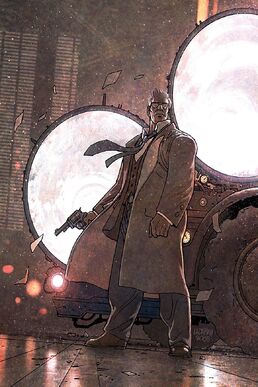
Jim Gordon in the comics.
Husband of Barbara and father of James Jr. and Barbara, James Gordon was a cop for many years in Chicago, where he eventually got himself into trouble taking down a couple of corrupt fellow officers. Due to the potential fallout, it was suggested strongly that he take a detective position in Gotham City. It did not take long after his arrival in Gotham City to realize that it was even more corrupt and his seemingly only ally against the corruption was a suspicious new vigilante called Batman.
Through his alliance with Batman, Gordon reduced Gotham City's corruption and eventually rose to the rank of police commissioner.In most versions of the Batman mythos, he is at one point or another depicted as Gotham City's police commissioner. He succeeded Commissioner Grogan in the rank at GCPD. Gordon frequently contacts Batman for help in solving various crimes, particularly those committed by supervillains. Because DC Comics retconned its characters' history in the 1985 miniseries Crisis on Infinite Earths and because of different interpretations in television and film, the details of Gordon's history vary from story to story. In the original pre-Crisis version of his history, Gordon was a police detective who initially bitterly resented the mysterious vigilante's interference in police business. Although the Batman seemed to fight on the side of justice, his methods and phenomenal track record for stopping crimes and capturing criminals embarrassed the police by comparison. Eventually, Batman met up with Gordon and persuaded the detective that they needed each other's help. Batman was deputized and worked with Gordon as an agent of the law.
The post-Crisis version of the character was introduced in the 1987 storyline Batman: Year One, written by Frank Miller. In this version, Gordon was transferred back to the city after spending more than fifteen years in Chicago. A man of integrity, Gordon found that his only ally against the mob-controlled administration was the Batman. One of the most significant differences in this version is that Batman was never deputized and Gordon's relationship with him was kept out of the public eye whenever possible. It was also added that he was a Special Forces veteran who was more than capable of hand to hand combat.
When Gordon needs to summon Batman, he uses the Bat-Signal, a specially modified Klieg searchlight with a stylized symbol of a bat placed on it so that it projects a large emblem shaped in Batman's bat insignia on the sky or buildings of Gotham City. Batman often disappears silently when Gordon's back is turned, often while Gordon is in the middle of a rant about legal red tape.The miniseries Gordon of Gotham takes place about twenty years prior to the current events of the DC Universe and ten years before coming to Gotham in Batman: Year One. It reveals that Gordon, during his tenure in Chicago, struggled with his wife over conceiving a child while taking university night classes in criminology. He faces brutality among other officers after uncovering corruption within the force. Later, Gordon uncovers evidence of rigging the mayoral election and brings down two of his fellow officers, which leads to his commissioner recommending to him that he transfer to Gotham quickly.
In the 1988 graphic novel Batman: The Killing Joke, the Joker kidnaps Gordon after shooting and paralyzing Barbara Gordon. He then cages Gordon in the freak show of an abandoned amusement park and forces him to look at enlarged photos of his wounded daughter in an effort to drive him insane, thus proving to Batman that even the most grounded, seemingly normal people can lose their minds after having "one bad day." Batman eventually apprehends the Joker and rescues Gordon. Despite the intense trauma he has endured, Gordon's sanity and code of ethics is intact: he insists that Batman apprehend the Joker without harming him in order to "show him that our way works." In the aftermath of her paralysis, Barbara is forced to end her career as Batgirl, but continues to fight crime as the wheelchair-bound Oracle, information broker to the superhero community and leader of the all-female superhero team, The Birds of Prey.
The No Man's Land storyline took place after Gotham was destroyed by an earthquake and isolated from outside assistance. Inside Gotham, Gordon struggled to maintain order amidst rampant crime. Batman was mysteriously absent for the initial three months and Gordon felt somewhat betrayed. He forged an uneasy alliance with Two-Face but was later double-crossed, kidnapped, as well as put on trial by Two-Face for breaking their "legally-binding" alliance. He escaped punishment and later met with Batman once again. In this confrontation, Gordon expressed his disgust towards Batman for letting Gotham "fall into ruin". Batman offered to prove his trust by revealing his secret identity, but Gordon refused to look when Batman removed his mask. Eventually their relationship was repaired.
Gordon fell in love with and married fellow officer Sarah Essen. However, Essen could not comprehend why Gordon needed Batman so much, which occasionally put a strain on their relationship. Unfortunately, she was fatally shot by the Joker at the end of the No Man's Land storyline. An enraged Gordon was able to restrain himself from killing Joker, shooting the Joker's knee instead. Not long after this, Gordon was gunned down by a crook seeking revenge for a previous arrest. Though seriously injured, he eventually pulled through. Gordon retired from the police force after having served more than 20 years in it. He remained in Gotham and occasionally enjoyed nighttime visits from Batman who came to him for company and advice. Commissioner Michael Akins had taken his position. After Barbara required surgery to save her life from the Brainiac virus, Gordon visited his daughter in Metropolis. She revealed to him her current role as Oracle, as well as her past as Batgirl. Gordon admitted that he knew of her life as Batgirl, but was pleasantly surprised to know of her career as the computer information broker of the heroes. He is very proud of her accomplishments.As part of DC's "One Year Later" Gordon has returned to the role of Commissioner: as of the year-long jump he has been back in the job for 3 months. The circumstances behind this are currently unknown, though there have been allusions to extreme corruption within the GCPD. These allusions are supported by events within Gotham Central, especially involving Detective Jim Corrigan. Most recently, Gordon survived an attempt on his life by the Joker (Batman #655), who had drugged him with Joker Venom in an attack on the GCPD. He was taken to the hospital in time.
The Commissioner is surprised when his son James Jr. returns to Gotham. Barbara tries to warn him that her step-brother is a psychopath, but young James confronts his father. He explains that he's taking medication for his psychopathic tendencies and asks his father not to get in the way of him getting a job with Leslie Thompkins. Gordon hunts down an old child murderer and begins to suspect that he might've been wrong about the young girl they believe his son killed as a child.Sonia Zucco is targeted by the super-villains Roadrunner and Tiger Shark, so Gordon has Batman help track down her friend's killer.Barbara runs tests on James Jr.'s medication and finds he's reversed the formula, to increase psychopathic tendencies instead of limit them. They realize he's using his job with Leslie Thompkins to turn thousands of infants into psychopaths like him. Barbara Eileen is attacked by toxin and they hunt down the Joker, but James Jr. reveals himself as the culprit when he kidnaps his step-sister. Batman hunts James Jr. down and stops him, the Commissioner shoots his own son in the legs and then stops him from jumping off a bridge. They're left unsure whether or not they really stopped his plan to turn infants into psychopaths, but it's implied he might have succeeded.
It was announced that DC Comics would relaunch their entire line and starting in September 2011 52 new #1's would begin to be released. Gordon is still the commissioner of the GCPD, but with some changes. One of them is of him having the red hair and mustache, from Batman: Year One. There were also changes with his family: He has never been married to anyone other than Barbara Gordon Sr. He and Barbara are once again the biological parents of Barbara "Babs" Gordon (aka Batgirl).Jim is still acting as commissioner of the GCPD. He has also returned to smoking, using it as an excuse to go outside and contact Batman. He is captured by new villain Dollmaker as revenge for Gordon killing his father many years ago. He is rescued by Batman before he is killed.
In the graphic novel by Geoff Johns and Gary Frank, Batman: Earth One, Jim Gordon is featured as a central character. In the story, he's a broken man, who's given up to fight corruption, until the emergence of the Batman. He's also partnered with a young fit Harvey Bullock. On the trail of the "Birthday Boy" killings, Gordon and Batman put aside each other's differences and stop him, saving his daughter, Barbara. James Gordon appears in the limited series Batman: The Dark Knight Returns, which presents a future where a retiring Gordon not only knows Batman's identity, but is good friends with Bruce Wayne. He then makes a cameo on Batman: The Dark Knight Strikes Again. Now retired, he wrote a book about Batman, who was believed to be dead.
Gordon is also referred to in the first issue of the series, All Star Batman and Robin the Boy Wonder, set in the same universe as and prior to The Dark Knight Returns. He made a full appearance on issue #6, as a police captain, having a conversations with his ex-partner, Sarah Essen, about Batman. He's still married to Barbara Kean Gordon, who is now an alcoholic, and has a son James Jr. Just as other continuities, his daughter, Barbara, who is fifteen, becomes Batgirl. Frank Miller has commented that the series is set in his Dark Knight Universe, which includes all of the Batman works by Frank Miller, therefore Barbara's inclusion confirms that Gordon had two children during Batman: Year One, at least in Miller's version of the continuity.
Gordon seems to be aware that Bruce Wayne is Batman, as he calls Wayne from his apartment, making several references to a recent conversation with the Dark Knight. In most versions of the mythos, Gordon is ignorant of Batman's identity. There is usually the implication Gordon is smart enough to solve the puzzle, but chooses not to in order to preserve Batman's effectiveness and maintain his own plausible deniability. In the 1966 Batman film, Gordon explicitly states his desire not to know for such a reason. In Batman: Year One, Gordon claims not to see the unmasked Batman well (whom his wife at that time, Barbara, also sees) because he doesn't have his glasses on. Gordon suspects early on that Bruce Wayne may be Batman, though he never follows up on his suspicions, although Sarah Essen is correct in her suspicions, even guessing Bruce's motivation. In Batman: The Animated Series, Gordon has implied he deliberately avoids deep investigation on the subject of Batman or Batgirl's identity (that of his own daughter, which he seems more sure of but cannot acknowledge it because that would put him in an uncomfortable legal position). Likewise, in the 1980s Detective Comics storyline Blind Justice, the world at large incorrectly supposes Batman is dead and Gordon comments to Bruce Wayne that Batman has earned the right to retirement if he so desires. He then rather pointedly asks Bruce's advice on whether or not he should reveal that Batman still lives. During No Man's Land, Batman attempts to regain Gordon's trust by revealing himself, but Gordon refuses to look at him, stating that if he wanted to know Batman's identity, he could have figured it out years ago and even cryptically saying, "And for all you know, maybe I did."During the Hush story arc, while working with Superman, Batman discusses whether or not Perry White has figured out Superman's secret identity. Theorizing that White is too good a reporter to not have figured it out, he draws the same comparison to himself and Gordon, stating that Gordon is too good a cop to not have figured it out. In that same story arc, Gordon, in an attempt to stop Batman from killing the Joker, tells Batman to remember who his role models are (his parents) and the beliefs they instilled in him. Plus, he asks Batman to remember who and what made him who he is, a rather obvious reference to the criminal who gunned down his parents in front of him, suggesting that Gordon knows that Bruce Wayne is Batman. Barbara reveals her identities to her father in Birds of Prey #89. Gordon then reveals that he was well aware of her status as the first Batgirl all along, though he purposefully avoided looking into what she was doing after she was paralyzed. Batman chides her for revealing herself, saying it was a mistake, but she counters that, while he taught her to fight criminals, it was her father who taught her to be human. In Blackest Night:Batman, Gordon is present when Deadman refers to the current Batman as "Grayson" and after the current Robin took Gordon and his daughter to the new Batman's underground base. It is implied that Gordon is unconscious when they meet Alfred Pennyworth.
In Frank Miller's The Dark Knight Returns, Gordon and Bruce Wayne are portrayed as close friends, with Gordon having discovered his identity years before.
In the Batman: Year 100 storyline which takes place in 2039, Captain Jim Gordon, grandson of Commissioner Gordon, finds an old laptop in the attic of a country home owned by Gordon and discovers a secret file which he assumes contains long-lost information on Batman. After unsuccessfully trying numerous passwords with relevance to the Batman universe he inputs "Bruce Wayne" and is granted access to the file contents.
Other faces of James Gordon[]
References[]
See also[]
Links[]
- James Gordon on Wikipedia
- James Gordon on DC Comics Database
- James Gordon on DCAU Wikia
- James Gordon at the Superfriends Wiki
- James Gordon at the Batman Wiki
- James Gordon on Young Justice Wikia
- James Gordon on Batman: the Brave and the Bold Wikia
- James Gordon on Injustice: Gods Among Us Wiki
- James Gordon on Beware the Batman Wiki
- James Gordon on Arkham Wiki
- James Gordon on Comic Vine


